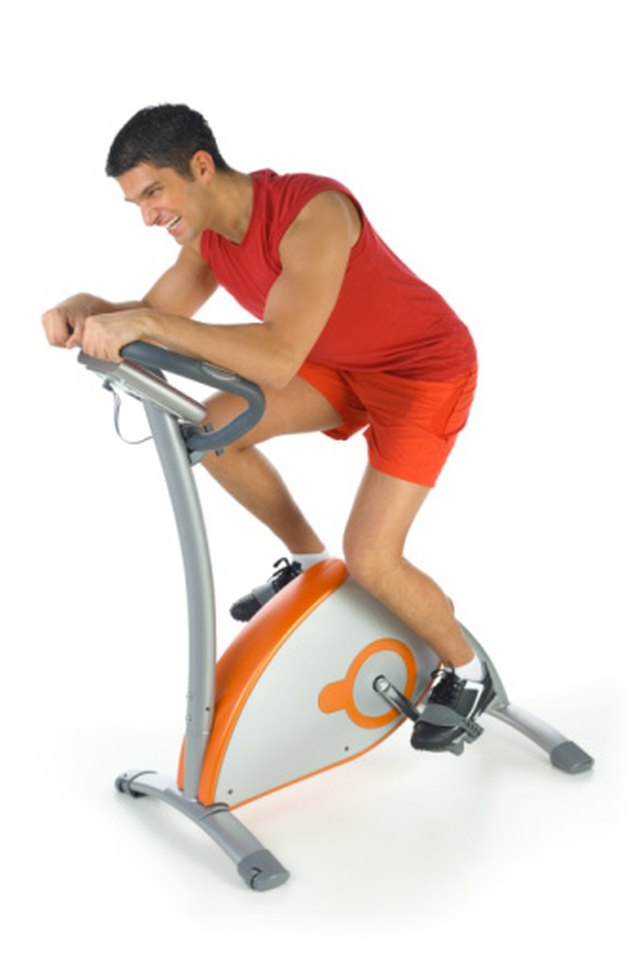Types of Stationary Bike Injuries

Indoor cycling has become a popular class found at clubs and studios everywhere. You can also order bikes that can be used at home. Indoor cycling offers an intense cardiovascular workout and can burn 400 to 500 calories in a 45- to 60-minute session. It is low impact, and you can work at your own level and build up to a more challenging routine. However, like any activity, if you do it improperly, too often or too vigorously, it can cause injuries. Your knees, hips and back are the most prone to injury while cycling indoors.
Knee Injuries
Due to the repetitive motion of cycling, injuries to the knees can occur in an indoor cycling class. This can be caused by overuse or not setting the seat correctly. When pedaling, set the seat height so that you have a slight bend in the knee when your foot and the pedal is at the bottom position. In addition, the seat should be forward enough so that your knee is over the center of the pedal. An improper bike setup and riding form can lead to tendons and ligaments becoming overstretched, pulled or tight. A common injury is patellar tendinitis, which is a chronic inflammation of the tendon that connects your kneecap (patella) to your shinbone.
Hip Injuries
Too much cycling and improper bike use can also cause problems in the hips. The repetitive forward motion of cycling can cause the piriformis muscle to become tight. This can put pressure on the sciatic nerve. In addition, since cycling is primarily a forward motion, the inner and outer thigh muscles can become weak and deconditioned, which leads to a muscular imbalance. You may develop pain in the buttocks, and it may radiate down to the hips and legs.
Back Injuries
Using improper posture while cycling indoors, such as leaning forward, hunching the shoulders and leaning too far from side to side, can cause the back muscles to become strained. The tendons and ligaments can be irritated, and there may be pressure on the disks. In addition, the back muscles can tighten. All of the situations can eventually lead to chronic back pain.
Wrist Injuries
Since indoor cycling is such an intense workout, you can become tired and may tend to lean too heavily on the handlebars, which can strain the wrists. Focus on letting your legs and abdominal muscles hold you up. Keep your wrists straight, and avoid excessive bending, which can place pressure on the nerves in the wrist. Place as little weight as possible on your wrists and hands when riding. If the wrists become injured, they may be painful, or you may experience numbness or tingling sensations in the wrist, hands or fingers.
Prevention/Solution
Indoor cycling injuries can be avoided. Check with your instructor to make sure you are setting up your bike correctly. Stretch your leg and back muscles after every ride. In addition, cross training with other cardiovascular activities will cut down on your risk of the above overuse problems. Adding in strength training exercises for the legs and core muscles will help you avoid muscular imbalances and help you to ride properly.
Explore In Depth
References
- Muyor JM. Exercise Intensity and Validity of the Ratings of Perceived Exertion (Borg and OMNI Scales) in an Indoor Cycling Session. J Hum Kinet. 2013;39:93-101. doi:10.2478/hukin-2013-0072
- Chavarrias M, Carlos-Vivas J, Collado-Mateo D, Pérez-Gómez J. Health Benefits of Indoor Cycling: A Systematic Review. Medicina (Kaunas). 2019;55(8). doi:10.3390/medicina55080452
- Lambourne K, Tomporowski P. The effect of exercise-induced arousal on cognitive task performance: a meta-regression analysis. Brain Res. 2010;1341:12-24. doi:10.1016/j.brainres.2010.03.091
- Bianco A, Bellafiore M, Battaglia G, et al. The effects of indoor cycling training in sedentary overweight women. J Sports Med Phys Fitness. 2010;50(2):159-65.
- Szabo A, Gáspár Z, Kiss N, Radványi A. Effect of spinning workouts on affect. J Ment Health. 2015;24(3):145-9. doi:10.3109/09638237.2015.1019053
Resources
Writer Bio
I hold a Master's degree in exercise physiology/health promotion. I am a certified fitness specialist through the American College of Spots Medicine and an IYT certified yoga teacher. I have over 25 years experience teaching classes to both general public and those with chronic illness. The above allows me to write directly to the reader based on personal experiences.
